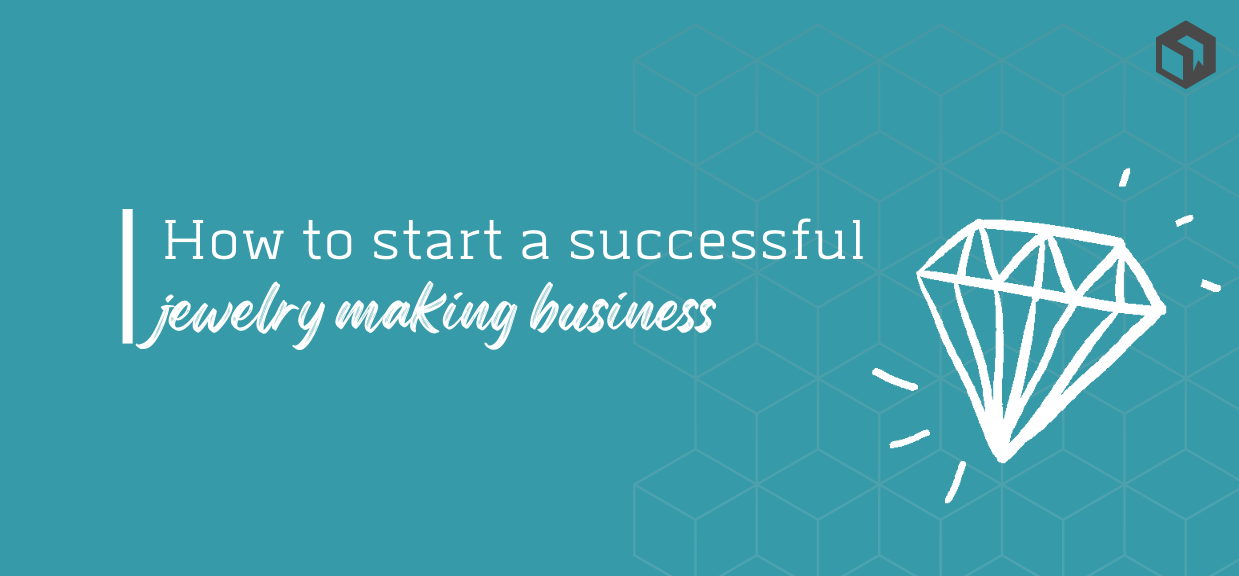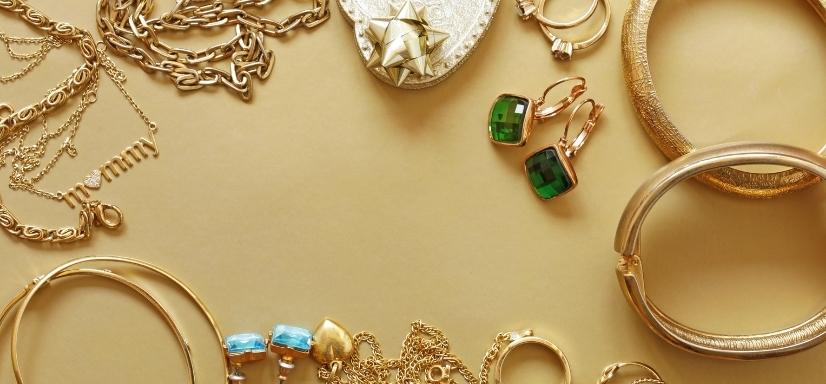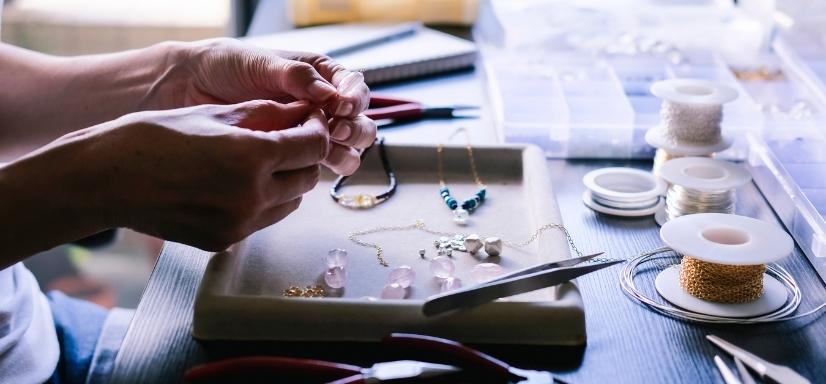How to Start a Jewelry Making Business
A jewelry making business can be a fun and rewarding way to earn a living. With a little creativity, patience, and practice, you can create beautiful pieces of jewelry that people will love to wear. Here are a few tips and tricks to get you started on your jewelry making journey.

A handmade jewelry making business can be a fun and rewarding way to earn a living. With online jewelry sales experiencing a 14.97% year on year growth in 2022, now is definitely the time to take the plunge and launch your online handmade jewelry empire!
So, just how do you go from making occasional jewelry pieces for friends and family to a thriving, growing enterprise? This article gives you a few tips and tricks to point you in the right direction.
Need to get your raw material and product inventory under control?
Try Craftybase - the inventory and manufacturing solution for DTC sellers. Track raw materials and product stock levels (in real time!), COGS, shop floor assignment and much more.
It's your new production central.
Write a (quick!) business plan

Creating a business plan is important for any business, but especially if you’re starting a handmade jewelry making business as you will potentially have higher than usual operating costs due to raw materials like precious metals and findings.
It’s important to note here that this plan does not need to be an “all singing, all dancing” affair - you can start with the basic framework on your strategy and keep refining it as you learn more about the jewelry market and the products you want to sell.
There are many free business plan templates available on the web, and even some (like this one) designed specifically for jewelry businesses.
As a general rule, a jewelry business plan should include:
- your goals and objectives (what do you want to get out of starting your own jewelry business?)
- how you plan to achieve them (the steps between now and selling your jewelry successfully)
- your target market (who are you going to sell your jewelry to?)
- where are you going to sell your jewelry products
- how are you going to reach your target customers
- a rundown of expenses and other operating costs, and estimated cashflow
Research the competition

It’s important to research the competition before starting any business, but this is especially the case if you’re planning on starting a handmade jewelry making business. Why? although the market is growing rapidly, there are still thousands of other jewelry makers running successful businesses with products that are likely to be similar to yours in some way.
In this research period, you’ll want to:
- find out what other jewelers are selling
- what their prices are and what quality of materials they are using
- where they are selling (Etsy? Shopify? WooCommerce? Faire? A combination of all?)
- what kind of reputation they have (check out their ratings and comments for a good source)
- how they are marketing their products (are they appearing in search results?)
This information will then enable to you refine the business goals for your jewelry business, and allow you to have more confidence in what products you will sell, how you will reach your target market, and also what pricing strategy you will use.
Decide what kind of jewelry you want to make.

Do you want to focus on making bracelets, necklaces, or earrings? Or do you want to be a jack-of-all-trades and make all kinds of different jewelry? Once you have an idea of the type of jewelry you want to make, you can start to research what supplies you will need and where you can get them.
Selling batch or made-to-order jewelry
When it comes to deciding on your product range, an important note is that made to order jewelry is typically more expensive than batch production jewelry because each piece is unique and made specifically for the customer. This also means that the target market for made to order jewelry is usually people who are willing to pay more for a one-of-a-kind piece, or people who are looking for a specific type of jewelry that they can’t find anywhere else.
On the other hand, batch production jewelry is made in large quantities and is therefore usually (but not always) less expensive. This makes it more appealing to a wider range of people, including those who are looking for a bargain.
The advantage of batch can be that once you have your product range finalised, you can spend time to hone your production production process. This will allow you to ensure your prices and margins as as optimized as possible. Another advantage of batch jewelry making is that you can and you can also consider outsourcing if it makes financial sense to do so (we recommend creating docs from the outset to make this step as easy as possible - read our article here for more details: How to create SOPs for your product business).
Choose a great jewelry business name.
A good name is important for any business, but it’s especially critical for a small jewelry business. Why? Because jewelry is all about emotion. When people are buying jewelry, they’re not just looking for something functional - they’re looking for something that speaks to them on an emotional level. And the right name can help you tap into that.
👉 Read our article for great ideas on names for your jewelry business →
Spend time on your jewelry logo design.
Your jewelry logo is the first thing your potential customers will see.
A great logo communicates what you sell and what your business stands for - before visitors even get to the stage of looking at the products that you offer. For this reason, when getting your jewelry business off the ground, it’s essential to spend time coming up with the right logo to ensure that you connect with your customers.
👉 Read our article for tips on how to create the perfect logo for your jewelry business →
Work on your jewelry production process.

Before you start selling your jewelry, it’s important to practice making it first until you have a reliable process that minimises mistakes and produces consistent quality pieces.
This will help you get a feel for how long each piece takes to make and ensure it is acceptable given the price you are intending to sell your jewelery product at.
This will make sure you have a firm grasp on your internal labor costs which will be handy when calculating your profit margins (more on this below!)
Ensure you have a profit margin on your jewelry from the outset
When you’re just starting out, it can be tricky to know how to price your jewelry. You want to make sure that you’re charging enough to cover the cost of materials and your time, but you don’t want to scare customers away with high prices. A good rule of thumb is to start by calculating the cost of materials for each piece and then adding on an additional 20-30% for your time and labor. This will help you ensure that you’re making a profit from each sale.
Craftybase can help new jewelry businesses track their inventory and margins, which is critical to ensuring the success of the business. With Craftybase, you can easily see how much each piece of jewelry costs to make, as well as your total profit for each sale. This information is crucial in order to ensure that you are making a profit and that your business is growing. Additionally, Craftybase can help you keep track of your customer orders and invoices, which can save you a lot of time and hassle.
Consider selling your jewelry range online.
While there is nothing wrong with sticking to offline sales channels like boutiques and markets in your local area, if you’d like to grow your business and reach bigger markets it’s important to consider selling online.
Selling jewelery online has come a long way since the early days of the internet - there are now a huge range of options, from Etsy (a marketplace specifically for handmade craft sellers) to newer options like Faire (for selling your jewelry wholesale).
Before you start selling your jewelry online, it’s best to do some research to find out which platform is right for you. For those just starting out, we tend to recommend using Etsy as a starting point as it comes with existing customers that are searching for products like yours. If you are more advanced and want to create your own brand you might like to consider setting up a WooCommerce or Shopify store.
Promote your jewelry business

The most successful jewelry businesses all have one thing in common - they have a marketing strategy. This is a plan for how you are going to reach enough of your target customers in order to make consistent sales (and hence grow your jewelry business).
Even if you are selling on a marketplace like Etsy, you’ll need a strategy to enable you to stand out from the competition and appear in the right search results. Take a look at our [Etsy SEO] article for how to optimize your listings.
Offline sales are another story in terms of how you best reach your customers - you’ll need to research the opportunities around craft fairs in your area to see if they are a good fit for your products. Developing relationships with local boutiques to develop a consignment strategy for your jewelry is also a great way of getting the sales rolling in.
Have a inventory management strategy in place from the get go
Inventory management is important for any business, but it’s especially crucial for jewelry businesses. As a small business owner, you need to balance stocking enough inventory to meet demand without having too much excess stock that can eat into your profits.
Starting off with Excel for inventory management is an effective and cost-efficient solution for many budding jewelry businesses. Its familiar interface and versatile functionality facilitate easy tracking of inventory, costs, and sales. However, as your jewelry business expands, you’ll likely find that a spreadsheets becomes insufficient (saying this, we also have a free jewelry inventory spreadsheet you can download if you feel this is the best option for you just now).
The lack of real-time updates, difficulty in tracking individual jewelry pieces, and increasing complexity in managing vast datasets can lead to confusion and errors. Moreover, Excel lacks the integrative capabilities needed for e-commerce platforms, which can limit your growth in an ever-expanding digital marketplace.
Starting out with dedicated jewelry inventory management software, like Craftybase, is a more scalable and robust solution as your business grows.
Craftybase’s inventory management tools make it easy to keep track of your inventory levels and identify which products are selling well and which ones need a boost. With real-time tracking, you’ll always know exactly how much stock you have on hand, saving you time and hassle when fulfilling orders. Keep track of your bill of materials, production schedules and more with our all in one software.
Reach new heights with your jewelry business by using Craftybase - the only inventory and manufacturing software designed specifically for DTC small makers.
Join thousands of other jewellers ensuring their pricing, inventory and costs are in control. Try us free for 14 days today!
